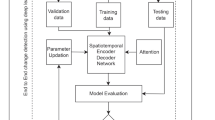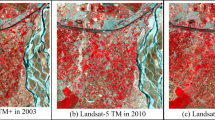Abstract
The Earth is frequently changed by natural occurrences and human actions that have threatened our environment to a certain extent. Therefore, accurate and timely monitoring of transformations at the surface of the Earth is crucial for precisely facing their harmful effects and consequences. This paper aims to perform a change detection (CD) analysis and assessment of the Dakshina Kannada region, being one of the coastal districts of Karnataka, India. The spatial and temporal variations in land use and land cover (LULC) are being monitored and examined from the data received as LULC maps from the National Remote Sensing Agency, Indian Space Research Organization, India. The time-series data from advanced wide-field sensor (AWiFS) Resourcesat2 satellite as LULC maps (1:250k) are analyzed using a deep learning approach with an encoder–decoder architecture with dual-attention modules for the change analysis. The model provides an overall accuracy and meanIOU(intersection over union) of 94.11% and 74.1%. The LULC maps from 2005 to 2018 (13 years) are utilized to decide the variations in the LULC, including urban development, agricultural variations, vegetation dynamics, forest areas, barren land, littoral swamp, and water bodies, current fallow, etc. The multiclass area-wise changes in terms of percentage show a decline in most LULC classes, which raises a point of concern for the environmental safety of the considered area, which is highly exposed to coastal flooding due to increased urbanization.











Similar content being viewed by others
Data availibility Statement
The data that support the findings of this study are available from [National Remote Sensing Centre, Indian Space Research Organization (ISRO), Government of India, Hyderabad India] but restrictions apply to the availability of these data, which were used under license for the current study, and so are not publicly available. Data are however available from the authors upon reasonable request and with permission of [National Remote Sensing Centre, Indian Space Research Organization (ISRO), Government of India, Hyderabad India].
Code availibility
Not applicable.
References
Antrop M (2009) Land-use changes affected by urban and industrial development. Land Cover, Land Use and the Global Change, Land Use, Land Cover and Soil Sciences-Volume I, p 169
Bai Y, Zhao Y, Shao Y, Zhang X, Yuan X (2022) Deep learning in different remote sensing image categories and applications: status and prospects. Int J Remote Sens 43(5):1800–1847
Camilleri S, De Giglio M, Stecchi F, Pérez-Hurtado A (2017) Land use and land cover change analysis in predominantly man-made coastal wetlands: towards a methodological framework. Wetlands Ecol Manag 25(1):23–43
Chen L, Zhang H, Xiao J, Nie L, Shao J, Liu W, Chua T-S (2017) Sca-cnn: spatial and channel-wise attention in convolutional networks for image captioning. In: Proceedings of the ieee conference on computer vision and pattern recognition (pp. 5659–5667)
Chen H, Wu C, Du B, Zhang L, Wang L (2019) Change detection in multisource vhr images via deep siamese convolutional multiple-layers recurrent neural network. IEEE Trans Geosci Remote Sens 58(4):2848–2864
Cheng H, Wu H, Zheng J, Qi K, Liu W (2021) A hierarchical self-attention augmented laplacian pyramid expanding network for change detection in high-resolution remote sensing images. ISPRS J Photogram Remote Sens 182:52–66
Ding K, Huo C, Xu Y, Zhong Z, Pan C (2014) Sparse hierarchical clustering for vhr image change detection. IEEE Geosci Remote Sens Lett 12(3):577–581
District Planning, G.o.K. (2022). District Environmental Plan 2022. Retrieved from https://cdn.s3waas.gov.in/s33a835d3215755c435ef4fe9965a3f2a0/uploads/2022/04/2022040590.pdf/
Du S, Du S, Liu B, Zhang X (2021) Mapping large-scale and fine-grained urban functional zones from vhr images using a multi-scale semantic segmentation network and object based approach. Remote Sens Environ 261:112480
Erbek FS, Özkan C, Taberner M (2004) Comparison of maximum likelihood classification method with supervised artificial neural network algorithms for land use activities. Int J Remote Sens 25(9):1733–1748
Fu J, Liu J, Tian H, Li Y, Bao Y, Fang Z, Lu H (2019) Dual attention network for scene segmentation. In: Proceedings of the ieee/cvf conference on computer vision and pattern recognition (pp. 3146–3154)
Gliessman SR, Engles E, Krieger R (1998) Agroecology: ecological processes in sustainable agriculture. CRC Press
Gil-Yepes JL, Ruiz LA, Recio JA, Balaguer-Beser Á, Hermosilla T (2016) Description and validation of a new set of object-based temporal geostatistical features for land-use/land-cover change detection. ISPRS J Photogram Remote Sens 121:77–91
Hansen MC, Potapov PV, Pickens AH, Tyukavina A, Hernandez-Serna A, Zalles V et al (2022) Global land use extent and dispersion within natural land cover using landsat data. Environ Res Lett 17(3):034050
Hussain M, Chen D, Cheng A, Wei H, Stanley D (2013) Change detection from remotely sensed images: from pixel-based to object-based approaches. ISPRS J Photogram Remote Sens 80:91–106
Jackson DL (2002) The farm as natural habitat: reconnecting food systems with ecosystems. Island Press
Khelifi L, Mignotte M (2020) Deep learning for change detection in remote sensing images: comprehensive review and meta-analysis. IEEE Access 8:126385–126400
Kremsa VŠ (2021) Sustainable management of agricultural resources (agricultural crops and animals). In: Sustainable resource management (pp. 99–145). Elsevier
Lv ZY, Liu TF, Zhang P, Benediktsson JA, Lei T, Zhang X (2019) Novel adaptive histogram trend similarity approach for land cover change detection by using bitemporal very-high-resolution remote sensing images. IEEE Trans Geosci Remote Sens 57(12):9554–9574. https://doi.org/10.1109/TGRS.2019.2927659
MohanRajan SN, Loganathan A, Manoharan P (2020) Survey on land use/land cover (lu/lc) change analysis in remote sensing and gis environment: techniques and challenges. Environ Sci Pollut Res 27(24):29900–29926
Mu L, Wang L, Wang Y, Chen X, Han W (2019) Urban land use and land cover change prediction via self-adaptive cellular based deep learning with multisourced data. IEEE J Select Top Appl Earth Observ Remote Sens 12(12):5233–5247. https://doi.org/10.1109/JSTARS.2019.2956318
Nedd R, Light K, Owens M, James N, Johnson E, Anandhi A (2021) A synthesis of land use/land cover studies: definitions, classification systems, meta-studies, challenges and knowledge gaps on a global landscape. Land 10(9):994
NRSC H (2010) National land use and land cover mapping using multi-temporal AWiFS data. Retrieved from https://bhuvanapp1.nrsc.gov.in/2dresources/thematic/LULC250/0809.pdf
Ojima D, Galvin K, Turner B (1994) The global impact of land-use change. BioScience 44(5):300–304
Papadomanolaki M, Vakalopoulou M, Karantzalos K (2021) A deep multitask learning framework coupling semantic segmentation and fully convolutional lstm networks for urban change detection. IEEE Trans Geosci Remote Sens 59(9):7651–7668
Richards J (1999) Remote sensing digital image analysis, vol 240. Springer, Berlin
Sefrin O, Riese FM, Keller S (2020) Deep learning for land cover change detection. Remote Sens 13(1):78
Shi S, Zhong Y, Zhao J, Lv P, Liu Y, Zhang L (2020) Land-use/land-cover change detection based on class-prior object-oriented conditional random field framework for high spatial resolution remote sensing imagery. IEEE Trans Geosci Remote Sens 60:1–16
Wang D, Chen X, Jiang M, Du S, Xu B, Wang J (2021) Ads-net: an attention-based deeply supervised network for remote sensing image change detection. Int J Appli Earth Observ Geoinform 101:102348
Wijaya H, Kurniawati H, Hutama S (2018) Industrialization impact on worker mobility and land use in peri urban area (case study of semarang district, indonesia). In: Iop conference series: Earth and environmental science (Vol. 123, p. 012037)
Woo S, Park J, Lee J-Y, Kweon IS (2018) Cbam: convolutional block attention module. In: Proceedings of the european conference on computer vision (eccv) (pp. 3–19)
Xie D, Zhang L, Bai L (2017) Deep learning in visual computing and signal processing. Appl Comput Intell Soft Comput 2017
Xing H, Zhu L, Chen B, Liu C, Niu J, Li X, Fang W (2022) A comparative study of threshold selection methods for change detection from very high-resolution remote sensing images. Earth Sci Inform: 1–13
Xu L, Herold M, Tsendbazar N-E, Masiliūnas D, Li L, Lesiv M, Verbesselt, J. (2022) Time series analysis for global land cover change monitoring: a comparison across sensors. Remote Sens Environ 271:112905
Yan J, Wang L, He H, Liang D, Song W, Han W (2022) Large-area land-cover changes monitoring with time-series remote sensing images using transferable deep models. IEEE Trans Geosci Remote Sens 60:1–17
Zhang C, Wei S, Ji S, Lu M (2019) Detecting large-scale urban land cover changes from very high resolution remote sensing images using cnn-based classification. ISPRS Int J Geo Inform 8(4):189
Zhang C, Yue P, Tapete D, Jiang L, Shangguan B, Huang L, Liu G (2020) A deeply supervised image fusion network for change detection in high resolution bi-temporal remote sensing images. ISPRS J Photogram Remote Sens 166:183–200
Zhi Yong L, Liu T, Benediktsson JA, Falco N (2021) Land cover change detection techniques: very-high-resolution optical images: a review. IEEE Geosci Remote Sens Mag
Zhu XX, Tuia D, Mou L, Xia G-S, Zhang L, Xu F, Fraundorfer F (2017) Deep learning in remote sensing: a comprehensive review and list of resources. IEEE Geosci Remote Sens Mag 5(4):8–36
Zhu Q, Guo X, Deng W, Guan Q, Zhong Y, Zhang L, Li D (2022) Land-use/land-cover change detection based on a siamese global learning framework for high spatial resolution remote sensing imagery. ISPRS J Photogram Remote Sens 184:63–78
Funding
No funding was received for conducting this study.
Author information
Authors and Affiliations
Contributions
All authors contributed to the study conception and design. Material preparation, data collection and analysis were performed by NN, KC, VMS and PP. The first draft of the manuscript was written by NN and all authors commented on previous versions of the manuscript. All authors read and approved the final manuscript.
Corresponding author
Ethics declarations
Conflict of interest
The authors have no competing interests to declare that are relevant to the content of this article.
Ethics approval
Not applicable.
Consent to participate
Not applicable.
Additional information
Publisher's Note
Springer Nature remains neutral with regard to jurisdictional claims in published maps and institutional affiliations.
This article is part of a Topical Collection in Environmental Earth Sciences on Deep learning for earth resource and environmental remote sensing, guest edited by Carlos Enrique Montenegro Marin, Xuyun Zhang and Nallappan Gunasekaran.
Rights and permissions
Springer Nature or its licensor (e.g. a society or other partner) holds exclusive rights to this article under a publishing agreement with the author(s) or other rightsholder(s); author self-archiving of the accepted manuscript version of this article is solely governed by the terms of such publishing agreement and applicable law.
About this article
Cite this article
Naik, N., Chandrasekaran, K., Sundaram, V.M. et al. Dual attention guided deep encoder-decoder network for change analysis in land use/land cover for Dakshina Kannada District, Karnataka, India. Environ Earth Sci 82, 33 (2023). https://doi.org/10.1007/s12665-022-10713-1
Received:
Accepted:
Published:
DOI: https://doi.org/10.1007/s12665-022-10713-1





